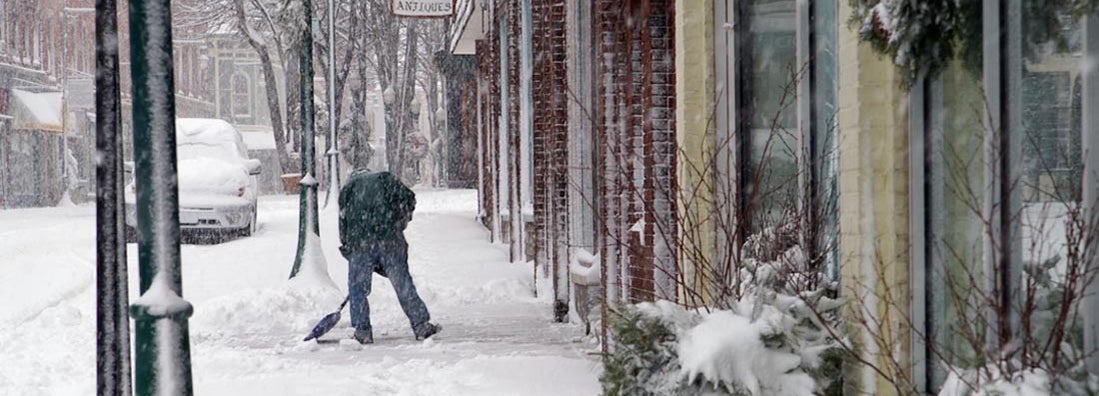How to Prepare Your Business for Winter

Snow, ice, freezing temperatures, and wind from winter storms can lead to property damage, employee illnesses or injuries, utility interruptions, and even possible business closures. If your business suffered a major loss, it’ s even likely that you’d be unable to recover and reopen.
That’s why you need to take some steps to prepare your business for winter.
Why Should You Prepare Your Business for Winter?
Burst pipes, flooding, ice damming, and heating system malfunctions are all potential problems your business can experience in winter. What’s more, your customers might be more susceptible to slip-and-fall injuries on your premises, while the weight of snow or ice can damage or collapse your roof, damaging everything inside, too.
Any of these problems can lead to insurmountable repair costs, extended business interruptions and loss of revenue, and even lawsuits if a customer is injured on your premises. Preparing your business for winter not only helps you avoid potential problems, but can also help you avoid costly shutdowns and devastating lawsuits.
What Steps Should You Take to Prepare Your Business for Winter?
According to the Small Business Association, the first step in preparing your business for winter is to identify potential weather-related threats that are common in your region. Is your area prone to heavy snowfall, ice, or high winds? Does your region experience freezing temperatures? Is rain a bigger threat?
Start with checking your business insurance and understanding what kind of coverage you have. Before anything goes wrong, it’s important to understand what kind of coverage you have and what you need to do if you have to file a claim.
Next, take some tangible steps to get your building and property ready for the winter months. Here’s a list of items that you need to be sure to take care of.
- Prevent slip-and-fall accidents. These seemingly minor accidents are more likely to occur in the winter, and can easily lead to lawsuits. Clear sidewalks and parking lots of ice and snow regularly. Use a floor mat inside your front door, and immediately clean up water and snow that gets brought inside.
- Ensure pipes are properly insulated. An inadequately insulated pipe can burst, which can lead to flooding, water damage, and costly repairs.
- Have your HVAC system inspected. An expert should check your heating system for safety and functionality before the cold weather sets in.
- Check for weak, low-hanging branches. Branches like this can cause damage to your building’s exterior if they become covered with heavy ice and snow.
- Clear gutters of debris. Make sure your gutters are clear to allow melting snow on the roof to drain freely and avoid any roof leaks or foundation damage.
- Repair any existing roof damage. Strong winds, heavy snow, and ice can cause further damage to an already compromised roof. Repair any existing roof damage to avoid additional problems over the winter months.
- Heat any unused buildings. Don’t leave empty buildings or sections of your building unheated for extended periods. Frozen pipes and other structural damage can occur if your building is allowed to get too cold.
- Invest in a generator. A generator can keep your business operating even if there's a power outage.
- Inventory valuable equipment. If you do have a loss due to a winter storm or another winter-related event, you’ll have to quantify your losses to your insurance company. Take a complete inventory of your commercial property and valuable equipment and store it somewhere safely offsite.
Don’t Forget a Contingency Plan
Perhaps you’ve completed your winter prep checklist for your business, but maybe you’ve forgotten one of the most important things: a business contingency plan for if you actually experience a loss.
A severe storm or even extreme temperatures could force you to shut down for a day or several days. You need a plan for how your business will function and how you will minimize your losses.
Your business contingency plan should include things like where you’d set up a temporary shop after a disaster strikes, where your employees can work from, and so on. Here are a few things to consider when you’re making your plan.
- Identify essential equipment in case of a power outage. Have backup generators available.
- Put in place a backup heating source. Use alternate heating sources only in well-ventilated rooms to prevent a buildup of carbon monoxide.
- Use battery-powered smoke and carbon monoxide detectors. That way if the power goes out, these important safety devices will still be functional.
- Communicate with employees. Have a predetermined way to communicate with all employees to let them know if the store or office will be open that day.
- Communicate with customers. Be sure to communicate with customers about any adjusted hours or a closure due to a winter storm.
- Salt the sidewalks. Salt the sidewalks and parking lot outside your business to prevent ice from forming and causing slippery conditions for your customers.
Does My Business Insurance Cover Winter Storm Damage?
Chances are you have coverage for winter storm damage under your commercial property insurance policy. It’s important to understand what “perils” are covered by your policy. Some commercial property policies are called “named perils” policies, which means they only cover losses caused by perils named specifically in the policy. These named perils policies are available in basic and broad form, with different covered perils named in each.
You may also have special form commercial property coverage, which covers all perils except those specifically excluded in the policy.
Basic named perils policies typically cover:
- Fire
- Lightning
- Explosion
- Smoke
- Aircraft, watercraft, or land vehicle collision
- Riot
- Vandalism
- Wind damage
- Hail damage
- Sinkhole collapse
- Volcanic activity
Broad form named perils policies typically cover:
- Falling objects that impact the exterior of the building
- Theft
- Weight of ice and snow
- Frozen pipes
- Accidental water damage
- And the perils named in a basic policy
Special form policies cover all perils unless they are specifically excluded.
It’s important to discuss these policy differences with an independent insurance agent before you purchase your policy. You need to purchase the policy that covers your risks appropriately and addresses the unique needs of your business.
Decorate Your Business Safely for the Holidays
Decorating your business for the holidays is much like decorating your home. You need to ensure that your festive decorations don’t create any additional risks for trip-and-fall injuries, fires, or other types of unnecessary risks for your customers or your business.
The US Consumer Product Safety Commission warns of the dangers of holiday decorations, and what we can do to minimize the risk. Here are just a few of their holiday decoration safety tips.
Candles
- Never use lighted candles to decorate a Christmas tree or near any other evergreens or flammable materials.
- Make sure all candleholders are non-flammable.
Christmas Trees
- Use non-combustible or flame resistant tree trimmings.
- If you have an artificial tree, make sure it is labeled as fire resistant.
- If you have a natural tree, make sure it is fresh. Look for needles that are hard to pull from the branches, and a trunk butt that is sticky with resin. When the trunk of the tree is bounced on the ground, few needles should fall off.
- Place your Christmas tree away from fireplaces, radiators, and other sources of heat.
Christmas Lights
- Use only lights that are labeled as having been tested for safety.
- Check each set of lights, new or old, for broken or cracked sockets, frayed or bare wires, or loose connections. Discard damaged light sets.
- Fasten outdoor lights securely to avoid wind damage.
- Use no more than three strands of lights per single extension cord.
- Turn off all lights and other electric powered decorations before going to bed or leaving your business.
- Never use electric lights on a metallic tree.
https://www.sba.gov/blog/prepare-your-small-business-winter-weather
